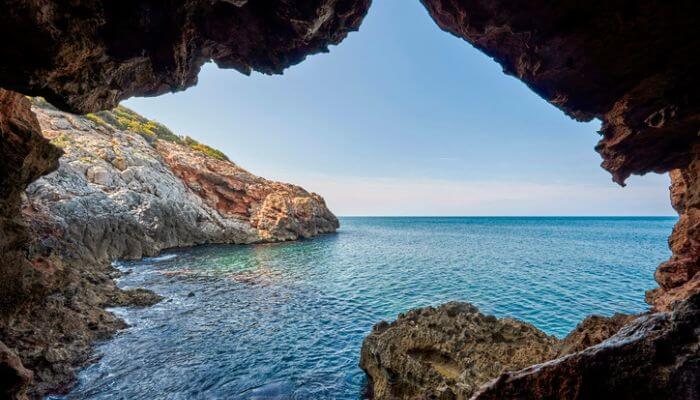Montgó Natural Park massif
This natural park narrates the history of mankind from the Upper Palaeolithic age. However, it also has many other things to show and tell us. In this article we’d like to help you discover them.
Where is Montgó Natural Park and what are its primary characteristics?
Montgó is a mountain whose main area is located in the municipality of Jávea and extends, in part, as far as Denia; both of these locations are in the province of Alicante. It is therefore one of the last foothills of the Baetic mountain ranges. Just barely 100 metres from the coast, the Montgó Massif Natural Park gives visitors the sensation of plunging into it.
Its maximum height is 753 metres and it has a total area of 2117.68 hectares. However, the entire protection area is up to 7500 hectares in size, as a result of the Spanish Natural Resources Management Plan. The objective is to create a perimeter that prevents biological isolation of the massif.
It has been protected as a Natural space since 1987, but when the Management Plan was established in 2002, the rich rocky seabed of Cape San Antonio in the very important Posidonia oceanica is now also protected. In addition, all the peripheral populations now benefit from an environment focused on sustainability.
Formation and historical curiosities of the Montgó Natural Park
It was formed mainly from Cretaceous materials when the African and European continental plates collided. As such, the abundance of limestone and marl gave rise to the formation of numerous caves, the main one being Cueva del Agua, located on its northern slope, 350 metres above sea level.
This abundance of caves possibly led to the development of the first Palaeolithic settlements that you will find at Montgó Natural Park. Arrows, spearheads, various utensils and the remains of burials in the Montgó and Barranc caves are proof of this.
But, in addition to these prehistoric settlements, you will also discover others from the Bronze Age, Iberian settlements, Arab sites and agricultural colonies. And let’s not forget the Romans, who used this natural watchtower as a lookout point for the important port of Denia.

Landscape, flora and fauna
The cliffs, which plunge into the sea from the flats of Cape San Antonio, bear the scars of their constant battle against storms and the pounding waves. As a human being, these impressive cuts make you feel tiny in the face of the strength and magnitude of nature’s titans.
But the Montgó massif is by no means completely devoid of life, the rainy and humid climate that characterises its northern slopes contributes to this. However, being the exact dividing line of the western Mediterranean climate, its southern side happens to be one of the most arid areas in the Valencian territory.
Far from being a problem for the habitat, this duality provides the massif with great diversity, making it marvellously full of life and contrast.

More than 650 plant species, many of which are endemic, germinate and take root on both sides. It is a real botanical treasure trove.
And where there is vegetation, there will be plenty of fauna. Animal species proliferate here in almost the same level of diversity. Cormorants, kestrels, hawks, gulls, eagle owls and eagles make short work of many other types of bird and fish in the area. Rabbits, hedgehogs and badgers also live in fierce competition with foxes and genets. Only the wild boars seem to feed on what the land provides, while the abundant and varied species of bats live on insects.
What to do at Montgó Natural Park
Aside from just enjoying watching the sunrise or sunset over the sea from the flat cliffs, you will certainly love the following suggestions as well.
Watching and photographing birds, flora and fauna
This is undoubtedly one of the most popular activities for those who already hold it in high esteem. We recommend referring to the Bird Watching brochures that are published by the Valencian Community. There is also a great deal of information at the El Montgó Natural Park Interpretation Centre in Denia.
Hike and bike trails
For this activity you will find the park guide particularly helpful. You can download it directly or get a copy from the Interpretation Centre. It highlights various itineraries and points of interest, such as the main caves and settlements.
Learn about history and prehistory
It is an extremely interesting cultural experience, with a wide variety of settlements that can be found in such a small space. It is almost like a tour through a museum that recounts most of the stages of humanity in the world.
You will find the park’s quarterly newsletter very helpful, with its articles related to each period.
Get moving now and plan your visit to Montgó Natural Park
Here we’ve given you all the tools you could need. Don’t miss your opportunity to discover Montgó Natural Park. But remember also that summer is coming, so you need to start planning your accommodation.






